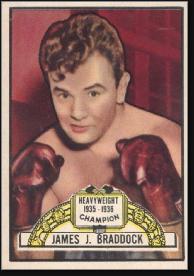
Sport: Boxing
Born: June 7, 1905
Died: November 29, 1974
Town: North Bergen, New Jersey
James Walter Braddock was born June 7, 1905 on the West Side of Manhattan and grew up in North Bergen, New Jersey. One of seven children born to Joe and Elizabeth Braddock, Jim worked various jobs as a teenager to help with family expenses. Tough and quick, he enjoyed playing football and briefly thought of going to college, but he wasn’t much of a student. Instead, he turned to boxing.
Jim competed as an amateur until he was 21 and then turned professional. He stood 6’2” and fought as a light heavyweight under the names James J. Braddock (evoking the name of Irish-American boxing legend James J. Corbett).
Jim’s powerful right hand served him well, as he strung together a series of impressive knockouts. One of his victims was heavyweight Pete Latzo. Jim broke his jaw with a punch in a 1928 meeting that was supposed to be a “tune-up” for Latzo’s November meeting with unbeaten Tuffy Griffiths in Madison Square Garden. The promoters had not choice but to put Jim in the ring as a 7–to-1 underdog. After nearly being knocked out in the opening round, Jim unleashed a savage barrage in the second, sending Griffiths to the canvas for a spectacular victory.
That earned Jim a shot at the Light Heavyweight belt in 1929 against Tommy Loughran. The veteran fighter managed to dodge Jim’s right for 15 rounds and held on to his championship. A couple of months later, the country tumbled into the Great Depression. Jim lost all of his savings and tried to make back the money taking fights for small purses. During a fundraising match for the Mount Vernon Police Department in 1933, he broke his hand and had to quit fighting. He had no choice at this point but to go one government relief. Soon his family, living in a shabby West New York flat, was hanging by a thread.
In 1934, his hand healed, Jim got a break when he was invited to fight Corn Griffin on the undercard for the Heavyweight championship bout between Primo Carnera and Max Baer. Both fighters hit the canvas in a wild second round, but against all odds, and with little time to train, Jim ended up beating Griffin on a TKO. While the state boxing commission was still skeptical of Jim’s fitness and health, they allowed him to fight John Henry Lewis. Again, Jim upset a heavy favorite, earning a 10-round decision. Four months later, Jim was paired with Art Lasky, the top heavyweight contender. It took him 15 brutal rounds, but he won a unanimous decision.

The press ran with the story of boxing’s “Cinderella Man” and, in the depths of the Depression, it played well. A hero to every struggling American, Jim was given a shot against Heavyweight champ Baer in the spring of 1935. Baer was one of history’s hardest punchers, and had actually killed an opponent with his sledgehammer right. The two faced off in the Madison Square Garden Bowl, an outdoor arena across the East River in Long Island City. Entering the fight as a 10-to-1 underdog, Jim dodged Baer’s right for 15 rounds, slowly wearing the champion down. When the final bell rang, Jim won the decision to become champion.
With his winnings, Jim paid back all of the relief money his family had been given. He also bought a house in North Bergen, where he lived the rest of his life with his wife, Mae.
One year later, Jim stepped into the ring with Joe Louis. Though Jim was the reigning champion, he was not expected to win the fight. The crowd went crazy when he caught the Brown Bomber with a hard right in the opening round and sent him crashing to the floor. Louis got up and pummeled Jim for 8 rounds until he could go no further. It was an exciting fight, but Jim was simply overmatched. He received 23 stitches in the dressing room afterwards. Jim fought one more bout, winning a split decision over England’s Tommy Farr in New York.
Though Jim was “out” of boxing, he continued to rake in thousands of dollars from the sport. One of the conditions his manager, Joe Gould, set for giving Louis a title shot was that Jim would receive 10% of the gate from Louis’s future fights for a period of 10 years. He made more than $150,000 from this deal.
During World War II, Jim served in the South Pacific as a lieutenant. Upon his return to the states, he got into the construction business and helped build the Verrazzano Bridge. In 1964, he was inducted into Ring Magazine’s Boxing Hall of Fame.
Jim passed away in 1974 at the age of 69. In 2001, he was inducted into the International Boxing Hall of Fame. In 2005, Russell Crowe starred in Cinderlla Man, a film directed by Ron Howard. Paul Giamatti played Joe Gould and won an Oscar for Best Supporting Actor. The role of the Braddocks’ neighbor, Sara, was played by Rosemarie DeWitt, Jim’s granddaughter.